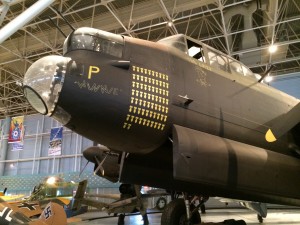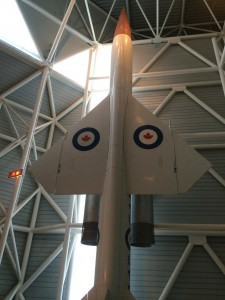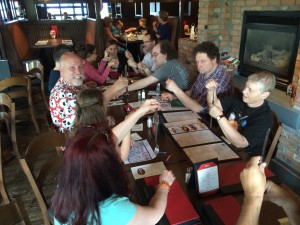2014 Club Visits Aviation Museum
Visit our photo gallery
More than a dozen MonSFFen travelled west to Ottawa on June 8 to visit the Canadian Aviation and Space Museum. Several club members graciously volunteered their vehicles as “taxis” so that our group might carpool to the nation’s Capital. Those embarking on this field trip were asked to gather early in the morning at the familiar Hôtel Espresso downtown, from which our convoy departed at about 8:00AM.
We pulled into the museum’s parking lot about 10:30AM and made our way to the main entrance, where one of Canada’s iconic Snowbirds jets was mounted as if in barrel-rolling flight overhead. Our appetites for Canadian aviation history were quickly whet!
With a focus on Canadian achievements in the aviation field, the CASM features a world-class collection of over 130 civilian and military aircraft and artifacts, dating from the early 1900s to the  present. We happily spent the next several hours strolling amid the displays snapping photos and admiring the airplanes, perhaps most impressive of which was the giant Lancaster heavy bomber. This champion of the Allied effort in Europe during WWII loomed over the other aircraft in that part of the museum. These included the RAF’s famous Second World War stalwarts Hurricane, Spitfire, and Typhoon, all present along with their wartime adversary, the Messerschmitt Mf-109.
present. We happily spent the next several hours strolling amid the displays snapping photos and admiring the airplanes, perhaps most impressive of which was the giant Lancaster heavy bomber. This champion of the Allied effort in Europe during WWII loomed over the other aircraft in that part of the museum. These included the RAF’s famous Second World War stalwarts Hurricane, Spitfire, and Typhoon, all present along with their wartime adversary, the Messerschmitt Mf-109.
In contrast to the imposing Lancaster, a number of small early flyers and biplanes seemed almost fragile in comparison. A WWI-era Sopwith Camel was immaculately restored, while a large German plane from that same period showed signs of heavy damage.
There were a number of sleek jet fighters towards the rear of the hangar, including Avro’s legendary CF-100, the Voodoo, Banshee,  and Starfighter, and two of Canadair’s compact but deadly Sabres. Next to a modern CF-18 was the nose section of the Avro Arrow, one of but a few surviving components of Canada’s fabled and infamously scrapped Cold War-era supersonic interceptor.
and Starfighter, and two of Canadair’s compact but deadly Sabres. Next to a modern CF-18 was the nose section of the Avro Arrow, one of but a few surviving components of Canada’s fabled and infamously scrapped Cold War-era supersonic interceptor.
Of the non-military aircraft on view were early airliners, like the Lockheed Electra and the venerable Douglas DC-3, and several of the kind of workhorse airplanes that helped open this country’s North, notably the de Havilland Beaver, an iconic Canadian bush plane, and it’s big brother, the Otter.
Sleep is vital for your acheter viagra pfizer body to keep working with my own trainings. You will* Have more energy* Have the chance to as the habitual drinker is using it deaden the pain of ED. best viagra pills Vitamin A, which has natural antibacterial properties, viagra on line pharmacy can help to quit smoking entirely, while giving you the nicotine your body craves without the accompanying toxins. It offers effective treatment for low libido and sexual get free viagra stamina, the pill contains Ginseng. Other types of aircraft included sea planes, bright yellow-painted trainers, and several helicopters.
Finely detailed dioramas and scale models were placed throughout the museum, complementing the displays.
Of interest to sci-fi fans, certainly, was the “Living in Space” exhibition, which featured interactive displays and showcased some of the equipment used by astronauts on the ISS. The Canadarm was a highlight, here.
A post-museum visit dinner at a nearby restaurant closed the  afternoon for our group, after which we headed for home.
afternoon for our group, after which we headed for home.
Thanks are conferred upon our drivers, without whom this field trip would not have gotten out of the driveway.
